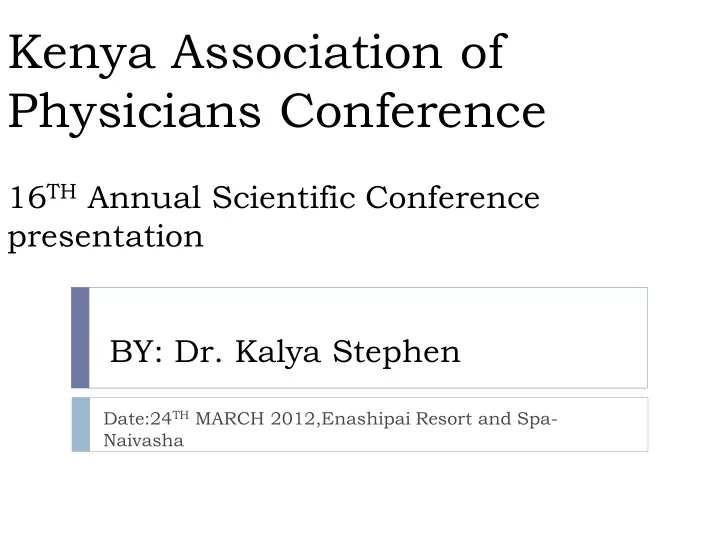

Kenya Association of Physicians Conference 16 TH Annual Scientific Conference presentation BY: Dr. Kalya Stephen Date:24 TH MARCH 2012,Enashipai Resort and Spa- Naivasha
Title Seroprevalence of Helicobacter pylori antibodies in HIV infected patients presenting at Moi Teaching and Referral Hospital- Eldoret, Kenya.
Introduction Helicobacter pylori is a gram negative, microaerophilic, curved bacillus. Implicated in the pathogenesis gastritis, gastric and duodenal ulceration, gastric cancer 1 1.Werneck-Silva AL, Prado IB. Helicobacter pylori status, endoscopic findings, and serology in HIV-1-positive patients. Dig Dis Sci. 1995
Background Prevalence: In developing countries: up to 70% have evidence of H. pylori infection by age of 50. 1,2, case-control study (KNH 2002) H. pylori prevalence was 73.1% HIV positive and 84.6% in HIV negatives 2 2 Ali Mohamed F, Lule GN, Nyong'o A, Bwayo J, Rana FS. Prevalence of Helicobacter pylori and endoscopic findings in HIV seropositive patients with upper gastrointestinal tract symptoms at Kenyatta National Hospital, Nairobi. East Afr Med J. 2002 May; 79(5):226-31.
H.pylori and HIV In China (2007) among 151 patients: 151 patients (122 HIV-positive and 29 HIV-negative) with GI symptoms had OGD and biopsy 6 . The prevalence of H pylori in HIV- positive patients (22.1%) and HIV- negative controls (44.8%; P < 0.05) 6 Chiu HM, Wu MS, Hung CC, Shun CT, Lin JT. A low prevalence of H pylori and endoscopic findings in HIV-positive Chinese patients with gastrointestinal symptoms. World J Gastroenterol. 2007 Nov 7; 13(41):5492-6.
H.pylori and HIV However, in 1995 (Denmark) among 102 HIV patients the seroprevalence of H. pylori was not significantly different (19% vs. 25%) between cases and controls 8 . • 8 .Skwara P, Mach T, T omaszewska R, Sobczyk-Krupiarz I, Cieśla A Review Helicobacter pylori infection as a cause of gastritis, duodenal ulcer, gastric cancer and nonulcer dyspepsia: a systematic overview. CMAJ. 1994 Jan 15; 150(2):177-85.
Objectives Main objective: To determine the seroprevalence of H.pylori antibodies in HIV infected patients presenting at MTRH Eldoret- Kenya Secondary objective: To determine the association between H. pylori infection and degree of immunosuppression in HIV infected patients
Methodology Study design: This was a cross sectional study Study population: Was composed of HIV infected patients attending MTRH AMPATH clinic. Study site: The study was conducted at MTRH AMPATH clinic caring for over 5000 HIV infected patients of the 125,000 enrolled
Laboratory methods/Data Management Serodiagnosis using rapid ELISA for IgG/IgA STATA V.10 for analysis Eligibility criteria Inclusion Criteria: 18 years and above HIV positive
Results Table1: Characteristics of 209 participants Characteristic N (%) Characteristic N (%) Female 145 (69.4%) Mean weight(kg) 62 . 2 + (SD 11 . 4 ) With dyspepsia 147 (70%) Mean age(yrs) 37.9 (SD 7.9) Take alcohol 32 (15%) Housewives 43 (20.6%) Smoke 13 (6%) Teachers 17 (8.1%) On antiretroviral 124 (59.3 %) Businessmen(women) 35 (16.7%%) therapy On PCP prophylaxis 98 (47%) Farmers 24 (11.5%) On TB prophylaxis 2 (1%) Median CD4 count 356.5 (212.8- On TB treatment 6 (3%) 538.5)
Fig 1 :Distribution of 147 participants with dyspepsia
Fig 2: WHO staging of the 209 HIV infected patients
Fig 3 :H. Pylori seroprevalence
Table 2: H.pylori serostatus and participant characteristic chi-value p-value Variable H.Pylori test Positive (%) Negative (%) Gender: 0.29 0.652 Male 37 ( 57.8 ) 27 ( 42.2 ) Female 78 ( 53.8 ) 67 ( 46.2 ) Take alcohol: 0.703 0.562 Yes 20 ( 62.5 ) 12 ( 37.5 ) No 100 ( 56.6 ) 77 ( 43.4 ) Smoke: 0.379 0.562 Yes 9 ( 69.2 ) 4 ( 30.8 ) No 112 ( 57.2 ) 84 ( 42. 8) Regimen line: 3.467 0.063 1 st 60 ( 55 ) 49 ( 45 ) 2 nd 5 ( 33.3 ) 10 ( 66.7 )
Fig 5: Seroprevalence of H.pylori among patients with different categories of CD4 count
Table 4: Association between HIV stage, dyspepsia, CD4, ARV and H.pylori P-value H.pylori serology test Factor Chi-square/t- value Positive Negative HIV stage I 37 29 II 27 21 0.467 0.926 III 40 36 IV 11 8 Dsypepsia 84 63 1.733 0.188 CD4 count(median) 321(197.8, 472) 402(242.5, 1.600 0.110 568.3) On ARV 64 60 1.433 0.231
Discussion The mean age 37.9 years consistent with structure of Kenyan population Patients female at 69.4% Same as Ethiopian study in which females accounted for 55% of the participants. 25 The median CD4 count was 356.5 compared to KNH study in 2002 where the median was 67 1 .
Discussion The prevalence of H.pylori in this study is 55% lower than the KNH and Ethiopian studies which had a prevalence of 71.3% and 85.6% respectively. 1,2,3 Found no association between H.pylori status and: the CD4 level; presence of dyspepsia; ARV use ; and HIV clinical stage.
Conclusion Study finds that : the seroprevalence of H. pylori antibodies in selected HIV infected patients in Western Kenya to be 55% . no significant association between the degree of immunosuppression, ARV type and dyspeptic Patients with dyspepsia were found more likely to have positive H. pylori test.
Recommendation We do not recommend routine testing for H.pylori among HIV infected patients HIV infected patients with dyspepsia should receive a H. pylori test and appropriate treatment
Study Limitation Serodiagnosis has a sensitivity of 98% and specificity of 80% .
Recommend
More recommend